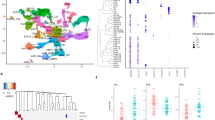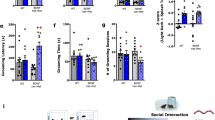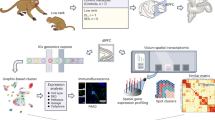Abstract
Major depressive disorder (MDD) is a prevalent mental illness that significantly impacts global health, with women showing twice the prevalence of men. This study employed the chronic social defeat stress (CSDS) model in female mice to investigate cellular and molecular changes in the prefrontal cortex (PFC) associated with depressive-like behaviors. Using single-nucleus RNA sequencing (snRNA-Seq), we examined transcriptomic alterations across various cell types in the PFC. Our results revealed that interneurons exhibited the most significant transcriptomic changes among all analyzed cell types. Notably, we found the Sox6+ interneurons (Sox6+Int) were enriched in the CSDS susceptible group. This enrichment was associated with enhanced inflammatory and immune responses, as well as alterations in synaptic function and mitochondrial pathways. Furthermore, we observed significant changes in cell-cell communication patterns, particularly between Sox6+Int and oligodendrocyte precursor cells (OPC). Weighted gene co-expression network analysis (WGCNA) identified several gene modules in Sox6+Int associated with specific depressive-like behaviors, implicating pathways related to inflammation, autophagy, and synaptic function. In particular, specific knockdown of Sox6 in neurons reversed the depressive-like behaviors. These findings provide novel insights into the cellular and molecular mechanisms underlying MDD in females, highlighting the potential role of Sox6+Int in stress-induced depression. Our study not only extends our understanding of the neurobiological basis of depression but also identifies potential therapeutic targets for sex-specific interventions in MDD treatment.
This is a preview of subscription content, access via your institution
Access options
Subscribe to this journal
Receive 12 print issues and online access
269,00 € per year
only 22,42 € per issue
Buy this article
- Purchase on SpringerLink
- Instant access to full article PDF
Prices may be subject to local taxes which are calculated during checkout






Similar content being viewed by others
Data availability
All data reported in this paper will be shared by the lead contact upon request. All raw sequencing data generated by this study are available in the Gene Expression Omnibus (GEO) repository under the accession number GSE291951.
Code availability
Code reported in this paper will be shared by the lead contact upon request.
References
GBD 2019 Mental Disorders Collaborators. Global, regional, and national burden of 12 mental disorders in 204 countries and territories, 1990-2019: a systematic analysis for the Global Burden of Disease Study 2019. Lancet Psychiatry. 2022;9:137–50.
Thompson SM. Modulators of GABA(A) receptor-mediated inhibition in the treatment of neuropsychiatric disorders: past, present, and future. Neuropsychopharmacology. 2024;49:83–95.
Lu J, Xu X, Huang Y, Li T, Ma C, Xu G, et al. Prevalence of depressive disorders and treatment in China: a cross-sectional epidemiological study. Lancet Psychiatry. 2021;8:981–90.
COVID-19 Mental Disorders Collaborators. Global prevalence and burden of depressive and anxiety disorders in 204 countries and territories in 2020 due to the COVID-19 pandemic. Lancet. 2021;398:1700–12.
Seney ML, Huo Z, Cahill K, French L, Puralewski R, Zhang J, et al. Opposite molecular signatures of depression in men and women. Biol Psychiatry. 2018;84:18–27.
Labonté B, Engmann O, Purushothaman I, Menard C, Wang J, Tan C, et al. Corrigendum: Sex-specific transcriptional signatures in human depression. Nat Med. 2018;24:525.
Lu CL, Ren J, Mo JW, Fan J, Guo F, Chen LY, et al. Glucocorticoid receptor-dependent astrocytes mediate stress vulnerability. Biol Psychiatry. 2022;92:204–15.
Wu J, Li Y, Huang Y, Liu L, Zhang H, Nagy C, et al. Integrating spatial and single-nucleus transcriptomic data elucidates microglial-specific responses in female cynomolgus macaques with depressive-like behaviors. Nat Neurosci. 2023;26:1352–64.
Zhang M, Zhi N, Feng J, Liu Y, Zhang M, Liu D, et al. ITPR2 mediated calcium homeostasis in oligodendrocytes is essential for myelination and involved in depressive-like behavior in adolescent mice. Adv Sci. 2024;11:e2306498.
Thompson SM, Kallarackal AJ, Kvarta MD, Van Dyke AM, LeGates TA, Cai X. An excitatory synapse hypothesis of depression. Trends Neurosci. 2015;38:279–94.
Li HH, Liu Y, Chen HS, Wang J, Li YK, Zhao Y, et al. PDGF-BB-Dependent neurogenesis buffers depressive-like behaviors by inhibition of GABAergic projection from medial septum to dentate gyrus. Adv Sci. 2023;10:e2301110.
Ma H, Li C, Wang J, Zhang X, Li M, Zhang R, et al. Amygdala-hippocampal innervation modulates stress-induced depressive-like behaviors through AMPA receptors. Proc Natl Acad Sci USA. 2021;118:e2019409118.
Bagot RC, Cates HM, Purushothaman I, Lorsch ZS, Walker DM, Wang J, et al. Circuit-wide transcriptional profiling reveals brain region-specific gene networks regulating depression susceptibility. Neuron. 2016;90:969–83.
Hultman R, Mague SD, Li Q, Katz BM, Michel N, Lin L, et al. Dysregulation of prefrontal cortex-mediated slow-evolving limbic dynamics drives stress-induced emotional pathology. Neuron. 2016;91:439–52.
Howard DM, Adams MJ, Clarke TK, Hafferty JD, Gibson J, Shirali M, et al. Genome-wide meta-analysis of depression identifies 102 independent variants and highlights the importance of the prefrontal brain regions. Nat Neurosci. 2019;22:343–52.
Yan Z, Rein B. Mechanisms of synaptic transmission dysregulation in the prefrontal cortex: pathophysiological implications. Mol Psychiatry. 2022;27:445–65.
Dong WT, Long LH, Deng Q, Liu D, Wang JL, Wang F, et al. Mitochondrial fission drives neuronal metabolic burden to promote stress susceptibility in male mice. Nat Metab. 2023;5:2220–36.
Lin S, Huang L, Luo ZC, Li X, Jin SY, Du ZJ, et al. The ATP level in the medial prefrontal cortex regulates depressive-like behavior via the medial prefrontal cortex-lateral habenula pathway. Biol Psychiatry. 2022;92:179–92.
Han S, Li XX, Wei S, Zhao D, Ding J, Xu Y, et al. Orbitofrontal cortex-hippocampus potentiation mediates relief for depression: a randomized double-blind trial and TMS-EEG study. Cell Rep Med. 2023;4:101060.
Tremblay R, Lee S, Rudy B. GABAergic interneurons in the neocortex: from cellular properties to circuits. Neuron. 2016;91:260–92.
Kepecs A, Fishell G. Interneuron cell types are fit to function. Nature. 2014;505:318–26.
Fogaça MV, Wu M, Li C, Li XY, Picciotto MR, Duman RS. Inhibition of GABA interneurons in the mPFC is sufficient and necessary for rapid antidepressant responses. Mol Psychiatry. 2021;26:3277–91.
Xie Y, Chen L, Wang L, Liu T, Zheng Y, Si L, et al. Single-nucleus transcriptomic analysis reveals the relationship between gene expression in oligodendrocyte lineage and major depressive disorder. J Transl Med. 2024;22:109.
Hughes BW, Siemsen BM, Tsvetkov E, Berto S, Kumar J, Cornbrooks RG, et al. NPAS4 in the medial prefrontal cortex mediates chronic social defeat stress-induced anhedonia-like behavior and reductions in excitatory synapses. Elife. 2023;12:e75631.
Wang F, Yang X, Ren Z, Chen C, Liu C. Alternative splicing in mouse brains affected by psychological stress is enriched in the signaling, neural transmission and blood-brain barrier pathways. Mol Psychiatry. 2023;28:4707–18.
Liu H, Zhu T, Zhang L, Li F, Zheng M, Chen B, et al. Immunization with a low dose of zymosan A confers resistance to depression-like behavior and neuroinflammatory responses in chronically stressed mice. Behav Pharmacol. 2024;35:211–26.
Xu JJ, Kan WJ, Wang TY, Li L, Zhang Y, Ge ZY, et al. Ganoderic acid A ameliorates depressive-like behaviors in CSDS mice: Insights from proteomic profiling and molecular mechanisms. J Affect Disord. 2024;358:270–82.
Golden SA, Covington HE 3rd, Berton O, Russo SJ. Corrigendum: a standardized protocol for repeated social defeat stress in mice. Nat Protoc. 2015;10:643.
Harris AZ, Atsak P, Bretton ZH, Holt ES, Alam R, Morton MP, et al. A novel method for chronic social defeat stress in female mice. Neuropsychopharmacology. 2018;43:1276–83.
Krishnaswami SR, Grindberg RV, Novotny M, Venepally P, Lacar B, Bhutani K, et al. Using single nuclei for RNA-seq to capture the transcriptome of postmortem neurons. Nat Protoc. 2016;11:499–524.
Arnsten AF. Stress weakens prefrontal networks: molecular insults to higher cognition. Nat Neurosci. 2015;18:1376–85.
Rosenberg AB, Roco CM, Muscat RA, Kuchina A, Sample P, Yao Z, et al. Single-cell profiling of the developing mouse brain and spinal cord with split-pool barcoding. Science. 2018;360:176–82.
Booeshaghi AS, Yao Z, van Velthoven C, Smith K, Tasic B, Zeng H, et al. Isoform cell-type specificity in the mouse primary motor cortex. Nature. 2021;598:195–9.
Scala F, Kobak D, Bernabucci M, Bernaerts Y, Cadwell CR, Castro JR, et al. Phenotypic variation of transcriptomic cell types in mouse motor cortex. Nature. 2021;598:144–50.
Südhof TC. Synaptic neurexin complexes: a molecular code for the logic of neural circuits. Cell. 2017;171:745–69.
Hing B, Mitchell SB, Filali Y, Eberle M, Hultman I, Matkovich M, et al. Transcriptomic evaluation of a stress vulnerability network using single-cell RNA sequencing in mouse prefrontal cortex. Biol Psychiatry. 2024;96:886–99.
Daskalakis NP, Iatrou A, Chatzinakos C, Jajoo A, Snijders C, Wylie D, et al. Systems biology dissection of PTSD and MDD across brain regions, cell types, and blood. Science. 2024;384:eadh3707.
Als TD, Kurki MI, Grove J, Voloudakis G, Therrien K, Tasanko E, et al. Depression pathophysiology, risk prediction of recurrence and comorbid psychiatric disorders using genome-wide analyses. Nat Med. 2023;29:1832–44.
Yang AC, Kern F, Losada PM, Agam MR, Maat CA, Schmartz GP, et al. Dysregulation of brain and choroid plexus cell types in severe COVID-19. Nature. 2021;595:565–71.
Wingo TS, Liu Y, Gerasimov ES, Gockley J, Logsdon BA, Duong DM, et al. Brain proteome-wide association study implicates novel proteins in depression pathogenesis. Nat Neurosci. 2021;24:810–7.
Levey DF, Stein MB, Wendt FR, Pathak GA, Zhou H, Aslan M, et al. Bi-ancestral depression GWAS in the Million Veteran Program and meta-analysis in >1.2 million individuals highlight new therapeutic directions. Nat Neurosci. 2021;24:954–63.
Direk N, Williams S, Smith JA, Ripke S, Air T, Amare AT, et al. An analysis of two genome-wide association meta-analyses identifies a new locus for broad depression phenotype. Biol Psychiatry. 2017;82:322–9.
Dattilo V, Ulivi S, Minelli A, La Bianca M, Giacopuzzi E, Bortolomasi M, et al. Genome-wide association studies on Northern Italy isolated populations provide further support concerning genetic susceptibility for major depressive disorder. World J Biol Psychiatry. 2023;24:135–48.
Dienel SJ, Fish KN, Lewis DA. The nature of prefrontal cortical GABA neuron alterations in schizophrenia: markedly lower somatostatin and parvalbumin gene expression without missing neurons. Am J Psychiatry. 2023;180:495–507.
Lan T, Li Y, Chen X, Wang W, Wang C, Lou H, et al. Exercise-Activated mPFC tri-synaptic pathway ameliorates depression-like behaviors in mouse. Adv Sci. 2025;12:e2408618.
Horie I, Muroi Y, Ishii T. Noradrenergic regulation of the medial prefrontal cortex mediates stress coping in postpartum female mice. Mol Neurobiol. 2025;62:137–55.
Nagy C, Maitra M, Tanti A, Suderman M, Théroux JF, Davoli MA, et al. Single-nucleus transcriptomics of the prefrontal cortex in major depressive disorder implicates oligodendrocyte precursor cells and excitatory neurons. Nat Neurosci. 2020;23:771–81.
Liu Y, Guo D, Yu B, Zeng T, Jiao FL, Bi YM. The effects and mechanisms of modified Xiaoyaosan on chronic unpredictable mild stress (CUMS)-induced depressive mice based on network pharmacology. J Ethnopharmacol. 2024;324:117754.
Sun X, Zhang T, Zhao Y, Cai E, Zhu H, Liu S. The protective effect of 5-O-methylvisammioside on LPS-induced depression in mice by inhibiting the over activation of BV-2 microglia through Nf-κB/IκB-α pathway. Phytomedicine. 2020;79:153348.
Uchida T, Furukawa T, Iwata S, Yanagawa Y, Fukuda A. Selective loss of parvalbumin-positive GABAergic interneurons in the cerebral cortex of maternally stressed Gad1-heterozygous mouse offspring. Transl Psychiatry. 2014;4:e371.
Hing B, Mitchell SB, Filali Y, Eberle M, Hultman I, Matkovich M, et al. Transcriptomic evaluation of a stress vulnerability network using single cell RNA-seq in mouse prefrontal cortex. Biol Psychiatry. 2024;96:886–99.
Joffe ME, Maksymetz J, Luschinger JR, Dogra S, Ferranti AS, Luessen DJ, et al. Acute restraint stress redirects prefrontal cortex circuit function through mGlu(5) receptor plasticity on somatostatin-expressing interneurons. Neuron. 2022;110:1068–83.e5.
Chen CC, Lu J, Yang R, Ding JB, Zuo Y. Selective activation of parvalbumin interneurons prevents stress-induced synapse loss and perceptual defects. Mol Psychiatry. 2018;23:1614–25.
Xu H, Liu L, Tian Y, Wang J, Li J, Zheng J, et al. A disinhibitory microcircuit mediates conditioned social fear in the prefrontal cortex. Neuron. 2019;102:668–82.e5.
Munguba H, Chattopadhyaya B, Nilsson S, Carriço JN, Memic F, Oberst P, et al. Postnatal Sox6 regulates synaptic function of cortical parvalbumin-expressing neurons. J Neurosci. 2021;41:8876–86.
Pi HJ, Hangya B, Kvitsiani D, Sanders JI, Huang ZJ, Kepecs A. Cortical interneurons that specialize in disinhibitory control. Nature. 2013;503:521–4.
Bloch M, Azem F, Aharonov I, Ben Avi I, Yagil Y, Schreiber S, et al. GnRH-agonist induced depressive and anxiety symptoms during in vitro fertilization-embryo transfer cycles. Fertil Steril. 2011;95:307–9.
Sepulcri Rde P, do Amaral VF. Depressive symptoms, anxiety, and quality of life in women with pelvic endometriosis. Eur J Obstet Gynecol Reprod Biol. 2009;142:53–6.
Tabassum S, Misrani A, Huang HX, Zhang ZY, Li QW, Long C. Resveratrol attenuates chronic unpredictable mild stress-induced alterations in the SIRT1/PGC1α/SIRT3 pathway and associated mitochondrial dysfunction in mice. Mol Neurobiol. 2023;60:5102–16.
Kuczynska Z, Metin E, Liput M, Buzanska L. Covering the role of PGC-1α in the nervous system. Cells. 2021;11:111.
Maitra M, Mitsuhashi H, Rahimian R, Chawla A, Yang J, Fiori LM, et al. Cell type specific transcriptomic differences in depression show similar patterns between males and females but implicate distinct cell types and genes. Nat Commun. 2023;14:2912.
Wilson PC, Wu H, Kirita Y, Uchimura K, Ledru N, Rennke HG, et al. The single-cell transcriptomic landscape of early human diabetic nephropathy. Proc Natl Acad Sci USA. 2019;116:19619–25.
Roppongi RT, Karimi B, Siddiqui TJ. Role of LRRTMs in synapse development and plasticity. Neurosci Res. 2017;116:18–28.
Roppongi RT, Dhume SH, Padmanabhan N, Silwal P, Zahra N, Karimi B, et al. LRRTMs organize synapses through differential engagement of neurexin and PTPσ. Neuron. 2020;106:108–25.e12.
Yamagata A, Goto-Ito S, Sato Y, Shiroshima T, Maeda A, Watanabe M, et al. Structural insights into modulation and selectivity of transsynaptic neurexin-LRRTM interaction. Nat Commun. 2018;9:3964.
Shen J, Xie P, Wang J, Yang F, Li S, Jiang H, et al. Nlrp6 protects from corticosterone-induced NSPC ferroptosis by modulating RIG-1/MAVS-mediated mitophagy. Redox Biol. 2024;73:103196.
Shi X, Zhou XZ, Chen G, Luo WF, Zhou C, He TJ, et al. Targeting the postsynaptic scaffolding protein PSD-95 enhances BDNF signaling to mitigate depression-like behaviors in mice. Sci Signal. 2024;17:eadn4556.
Liu Q, Zhao JN, Fang ZT, Wang X, Zhang BG, He Y, et al. BGP-15 alleviates LPS-induced depression-like behavior by promoting mitophagy. Brain Behav Immun. 2024;119:648–64.
Ding J, Adiconis X, Simmons SK, Kowalczyk MS, Hession CC, Marjanovic ND, et al. Systematic comparison of single-cell and single-nucleus RNA-sequencing methods. Nat Biotechnol. 2020;38:737–46.
Acknowledgements
This work was supported by the National Key R&D Program of China (STI2030-Major Projects 2021ZD0202400, STI2030-Major Projects 2021ZD0200600), the Natural Science Foundation Project of China (82171523, 82471545, 82401784, 32400850, 82401523, 82201688), National Reserve Talent Project in the Health and Wellness Sector of Chongqing (HBRC202410, HBRC202417), China Postdoctoral Science Foundation (2024MD754023), Science and Technology Research Program of Chongqing Municipal Education Commission (Grant No. KJZD-K202400404).
Author information
Authors and Affiliations
Contributions
PZ designed experiments. GJM, JW, JY and XYZ performed analysis and computation. GJM, YH and XMT performed all experiments. GJM, RMT and YYW constructed the animal model. GJM and JPZ created figures and drafted the manuscript. PZ, JW, JPZ, YH and XDS provided the fundings. YFL, PL and MHY performed data quality control. PZ, MLW and JL revised the manuscript for intellectual content. All authors reviewed and revised the final manuscript before submitting the manuscript.
Corresponding author
Ethics declarations
Ethics approval
All animal studies and experimental procedures were approved by the Animal Care and Use Committee of Chongqing Medical University (IACUC-CQMU-2023-0145), all methods were carried out in accordance with the relevant guidelines and regulations.
Competing interests
The authors declare no competing interests.
Additional information
Publisher’s note Springer Nature remains neutral with regard to jurisdictional claims in published maps and institutional affiliations.
Rights and permissions
Springer Nature or its licensor (e.g. a society or other partner) holds exclusive rights to this article under a publishing agreement with the author(s) or other rightsholder(s); author self-archiving of the accepted manuscript version of this article is solely governed by the terms of such publishing agreement and applicable law.
About this article
Cite this article
Ma, G., Wu, J., Wu, Y. et al. Single-cell transcriptomics reveals Sox6 positive interneurons enriched in the prefrontal cortex of female mice vulnerable to chronic social stress. Mol Psychiatry (2025). https://doi.org/10.1038/s41380-025-03088-9
Received:
Revised:
Accepted:
Published:
DOI: https://doi.org/10.1038/s41380-025-03088-9



